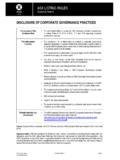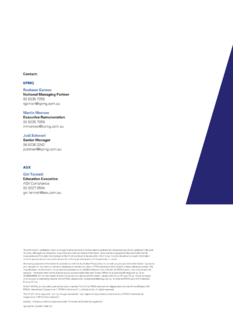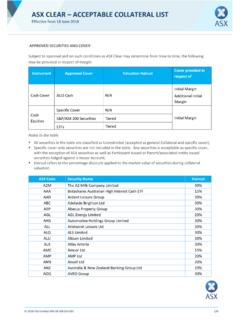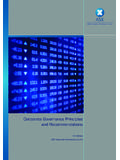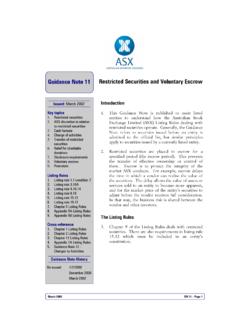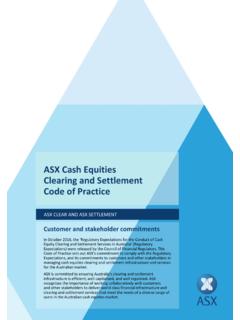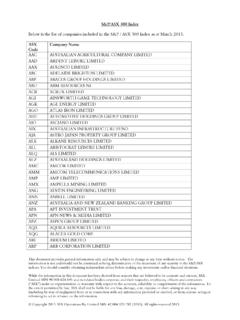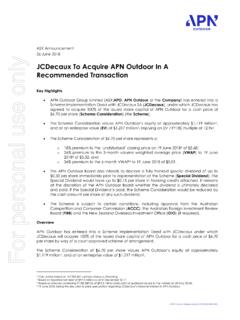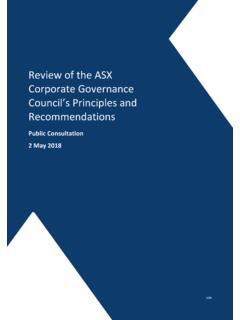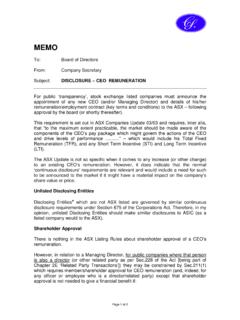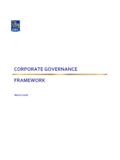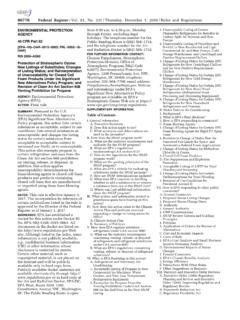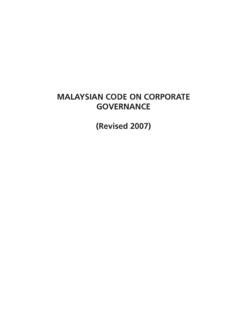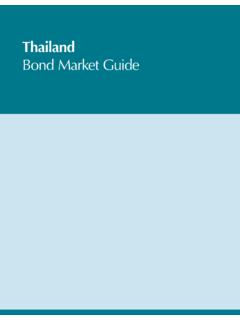Transcription of CONTINUOUS DISCLOSURE: LISTING RULES 3 - …
1 Important notice: ASX has published this abridged guide to assist listed entities and their officers to understand and comply with their CONTINUOUS disclosure obligations under the LISTING RULES . Nothing in this guide necessarily binds ASX in the application of the LISTING RULES in a particular case. In issuing this guide, ASX is not providing legal advice. Listed entities and their officers should obtain their own advice from a qualified professional person in respect of their obligations. ASX may withdraw or replace this guide at any time without further notice to any person. More detailed guidance on the issues covered in this guide can be found in ASX LISTING RULES Guidance Note 8 CONTINUOUS Disclosure: LISTING RULES , available on the ASX website at.
2 ASX LISTING RULES CONTINUOUS Disclosure: An Abridged Guide Page 1 CONTINUOUS Disclosure: an Abridged Guide 1. Introduction This Guide is published to assist listed entities and their officers to understand and comply with their disclosure obligations under LISTING RULES and These RULES provide: Once an entity is or becomes aware of any information concerning it that a reasonable person would expect to have a material effect on the price or value of the entity s securities, the entity must immediately tell ASX that information. LISTING rule does not apply to particular information while each of the following requirements is satisfied in relation to the information: One or more of the following 5 situations applies: It would be a breach of a law to disclose the information; The information concerns an incomplete proposal or negotiation; The information comprises matters of supposition or is insufficiently definite to warrant disclosure; The information is generated for the internal management purposes of the entity; or The information is a trade secret.
3 And The information is confidential and ASX has not formed the view that the information has ceased to be confidential; and A reasonable person would not expect the information to be disclosed. Compliance with LISTING Rule is critical to the integrity and efficiency of the ASX market and other markets that trade in ASX quoted securities or derivatives of those securities. Reflecting this, Parliament has given the rule statutory force in section 674 of the Corporations Act. If a listed entity breaches LISTING Rule , it may also breach section 674(2). This is a both criminal offence and a financial services civil penalty provision, punishable in the former case by a fine of up to $110,000 and in the latter case by a civil penalty of up to $1,000,000.
4 Alternatively, if ASIC has reasonable grounds to suspect a breach it may, by administrative action, issue an infringement notice imposing a penalty of up to $100,000. The entity may also be liable to pay damages to any person who suffers loss or damage as a result of the breach. An officer who is involved in such a breach may infringe section 674(2A) of the Corporations Act. This is a civil penalty provision punishable by a penalty of up to $200,000. The officer may also be liable to pay damages to anyone who suffers loss or damage as a result of the breach, although there is a due diligence defence in section 674(2B), which protects officers of a listed entity from civil penalties and civil claims for damages if they can prove that they took all steps that were reasonable in the circumstances to ensure that the entity complied with its CONTINUOUS disclosure obligations and, after doing so, believed on reasonable grounds that the entity was complying with those obligations.
5 It should also be noted that an officer or employee of a listed entity who gives, or authorises or permits the giving of, materially false or misleading information to ASX under LISTING Rule (including in response to any enquiry ASX may make of the entity under that rule) may commit a criminal offence under section 1309 of the Corporations Act. 2. An overview of the CONTINUOUS disclosure decision process The diagram on the next page outlines the decision process a listed entity should generally follow, if it becomes aware of information that could have a material effect on the price or value of its securities, to determine whether ASX LISTING RULES CONTINUOUS Disclosure: An Abridged Guide Page 2 the information needs to be disclosed under LISTING RULES and and, if it does and the entity is not in a position to issue an announcement straight away, whether it should consider requesting a trading halt.
6 Would a reasonable person expect the information to have a material effect on the price or value of the entity s securities?Is the information within one of these categories?1. It would be a breach of law to disclose the information2. The information concerns an incomplete proposal or negotiation3. The information concerns matters of supposition or is insufficiently definite to warrant disclosure4. The information is generated for internal management purposes5. The information is a trade secretIs the information confidential?Would a reasonable person expect the information to be disclosed in the circumstances?Has ASX advised that in its opinion the information is no longer confidential?
7 NoYesNoYesYesNoYesThe information must be disclosed immediately under LISTING Rule information is not required to be disclosed under LISTING Rule I make the announcement about the information straight away?Is the market currently trading?Will the announcement be ready for release prior to the next market open?NoYesYesNoNoRelease the announcement on the ASX Market Announcements Platform as quickly as you canConsider requesting a trading haltYes The questions in the second to fifth hexagons in the diagram above go to whether the information falls within the carve-outs to immediate disclosure in LISTING Rule It should be noted that these questions may need to re-appraised from time to time as circumstances change (eg, as a previously incomplete proposal or negotiation approaches completion or if the information has ceased to be confidential).
8 ASX LISTING RULES CONTINUOUS Disclosure: An Abridged Guide Page 3 3. What information does a listed entity have to disclose? LISTING Rule requires a listed entity to disclose information concerning it that a reasonable person would expect to have a material effect on the price or value of the entity s securities . This type of information is referred to in this Guide as market sensitive information . The notes to LISTING Rule give the following examples of the type of information that could be market sensitive: a transaction that will lead to a significant change in the nature or scale of the entity s activities; a material mineral or hydrocarbon discovery; a material acquisition or disposal; the granting or withdrawal of a material licence; the entry into, variation or termination of a material agreement; becoming a plaintiff or defendant in a material law suit; the fact that the entity s earnings will be materially different from market expectations; the appointment of a liquidator, administrator or receiver.
9 The commission of an event of default under, or other event entitling a financier to terminate, a material financing facility; under subscriptions or over subscriptions to an issue of securities (a proposed issue of securities is separately notifiable to ASX under LISTING Rule ); giving or receiving a notice of intention to make a takeover; and any rating applied by a rating agency to an entity or its securities and any change to such a rating. This list is by no means exhaustive and there are many other examples of information that potentially could be market sensitive. For these purposes, information extends beyond pure matters of fact and includes matters of opinion and intention.
10 It is not limited to information that is generated by, or sourced from within, the entity. Nor is it limited to information that is financial in character or that is measurable in financial terms. Under LISTING Rule , an entity must disclose all information concerning it that it becomes aware of from any source and of any character, if a reasonable person would expect the information to have a material effect on the price or value of its securities. 4. When is information market sensitive? The test for determining whether information is market sensitive and therefore needs to be disclosed under LISTING Rule is set out in section 677 of the Corporations Act.
